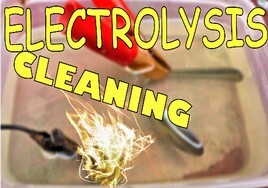Electrolysis Coin Cleaning
Coin Cleaning

How to Clean dirty silver and copper coins with Electrolysis.
Cleaning coins with electrolysis is a method that uses an electric current to remove dirt, tarnish, and corrosion from the surface of the coin.
It's considered a more advanced technique and should be used with caution, especially with valuable or collectable coins. Here's a step-by-step guide and video on how to clean coins using electrolysis:
Materials you'll need:
Power source: You'll need a low-voltage power source. A battery charger with adjustable voltage or a variable power supply is commonly used.
Electrolyte solution: This is the liquid that conducts electricity between the coins and the sacrificial electrode. You can use a solution of water and a suitable electrolyte, such as baking soda (sodium bicarbonate) or table salt (sodium chloride).
Plastic or glass container: It should be large enough to hold the coins and the sacrificial electrode, without them touching.
Graphite or stainless steel rod: This will serve as the sacrificial electrode. It should be clean and not in contact with the coins.
Wire: You'll need wires to connect the coins and the sacrificial electrode to the power source.
Crocodile clips or alligator clips: These will be used to attach the wires to the coins and the sacrificial electrode.
Safety gear: Safety goggles and gloves are recommended to protect your eyes and hands.
Steps to clean coins with electrolysis:
Prepare the setup:
Set up your container, ensuring it's large enough to hold the coins and the sacrificial electrode without them touching. Fill it with the electrolyte solution (water mixed with baking soda or table salt).
Attach the coins and the sacrificial electrode:
Connect one end of a wire to the positive terminal of the power source and attach the other end to one of the coins. Connect another wire to the negative terminal of the power source and attach the other end to the sacrificial electrode.
Immerse the coins and electrode:
Submerge the coins and the sacrificial electrode into the electrolyte solution. Ensure they do not touch each other.
Adjust the voltage:
Turn on the power source and set it to a low voltage (around 1-2 volts). Higher voltages can lead to more rapid electrolysis, but they also come with a higher risk of damaging the coins.
Monitor the process:
Watch the coins closely as the electrolysis process occurs. You should start to see small bubbles forming on the surface of the coins and the sacrificial electrode. This is an indication that the process is working.
End the process:
After a few minutes to an hour (depending on the level of cleaning needed), turn off the power source and carefully remove the coins and the sacrificial electrode from the solution.
Rinse and dry the coins:
Rinse the coins thoroughly with clean water to remove any residual electrolyte solution. Dry them using a clean, lint-free cloth.
Inspect the coins:
Examine the coins to see if they are now clean to your satisfaction.
Important tips and considerations:
Start with a low voltage: Begin with a low voltage and monitor the process closely. You can increase the voltage if needed, but do so with caution.
Use distilled water: It's best to use distilled water to prepare the electrolyte solution to minimise impurities.
Be cautious with valuable coins: Electrolysis can be an effective cleaning method, but it carries a risk of altering the coin's surface. It's advisable to seek professional advice, especially for valuable or historically significant coins.
Dispose of the electrolyte solution properly: If it contains any potentially harmful chemicals, be sure to follow local regulations for disposal.
Remember, while electrolysis can be an effective cleaning method, it may not be suitable for all coins, especially those with delicate surfaces or intricate details. Always exercise caution and consider seeking professional advice, especially for valuable or historically significant coins.
cleaning coins and silver with electrolysis

